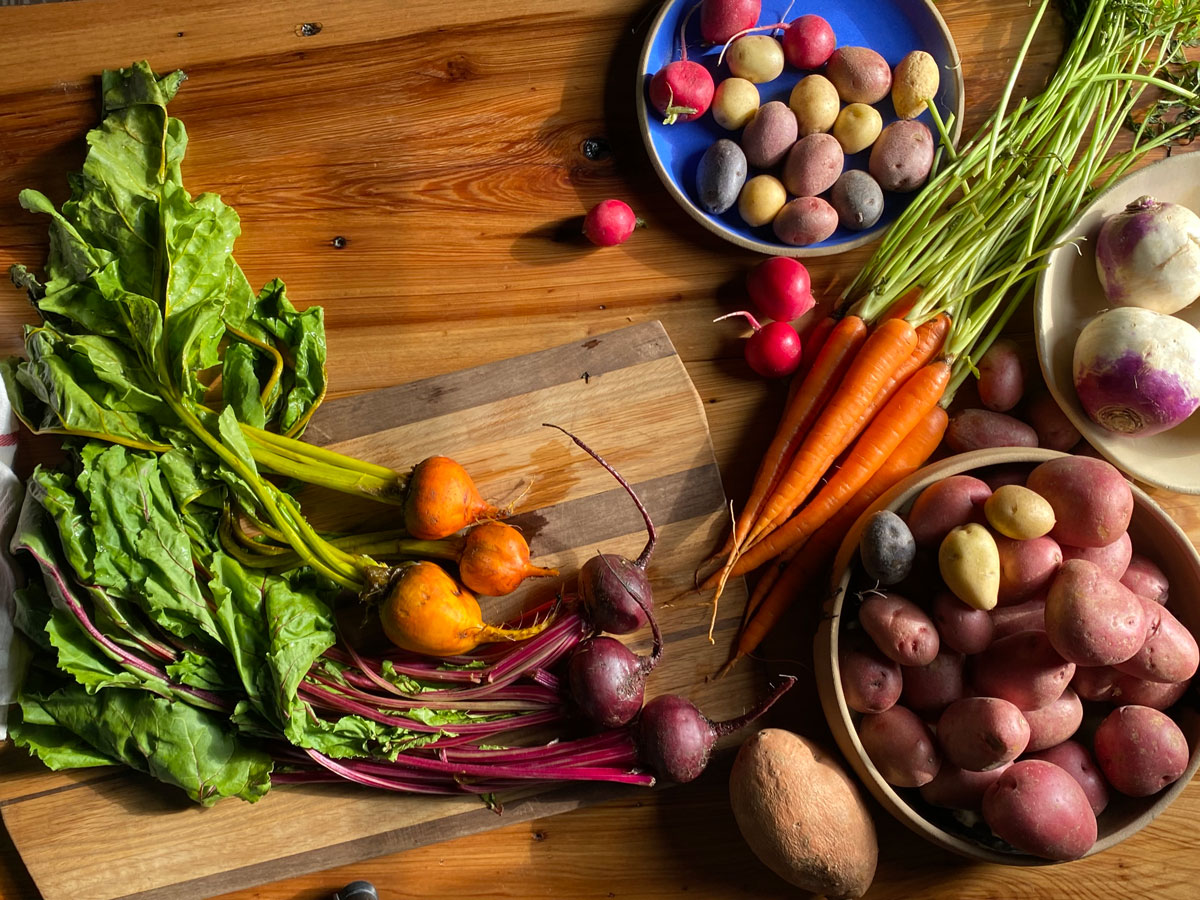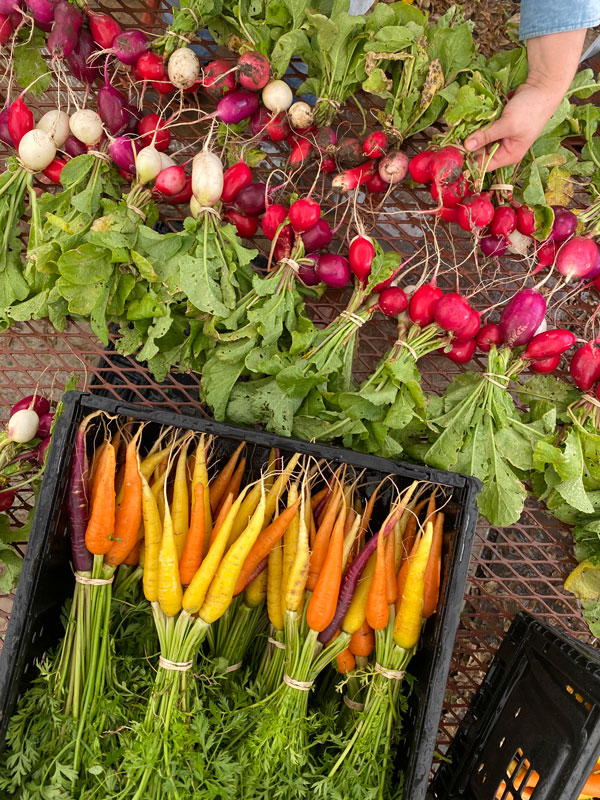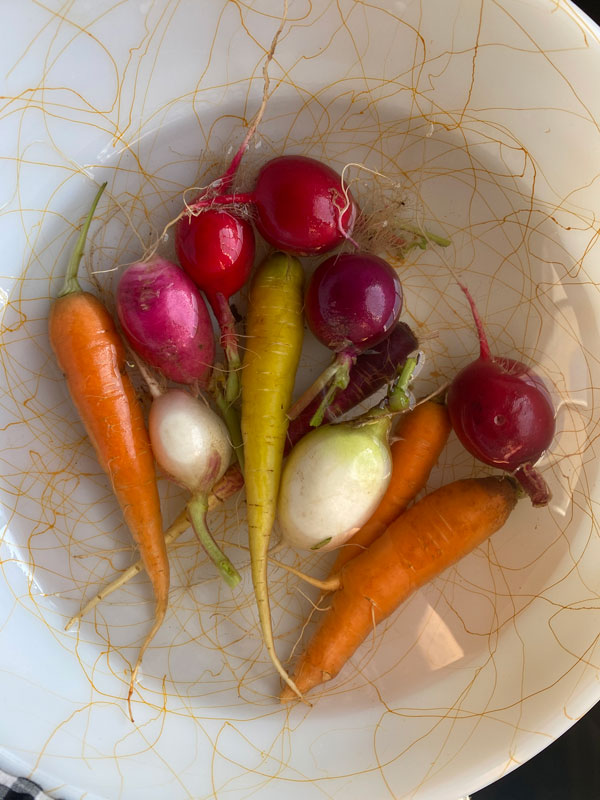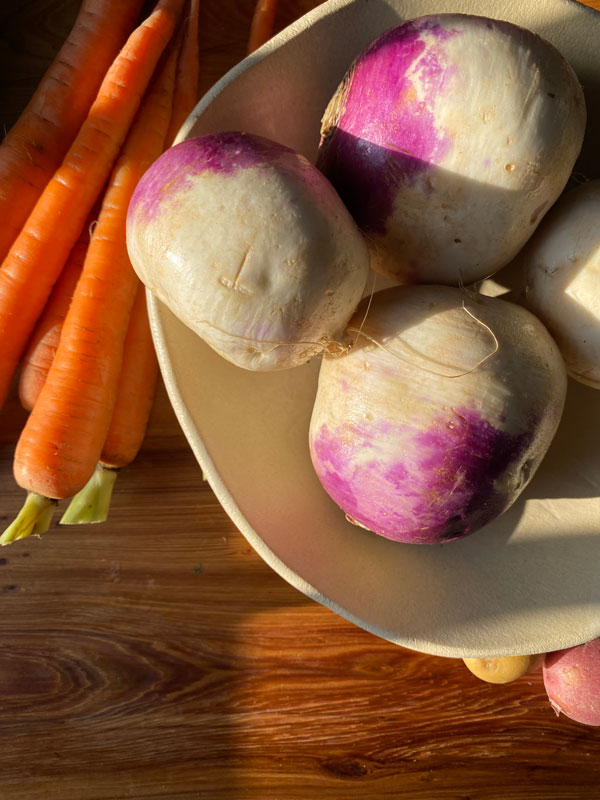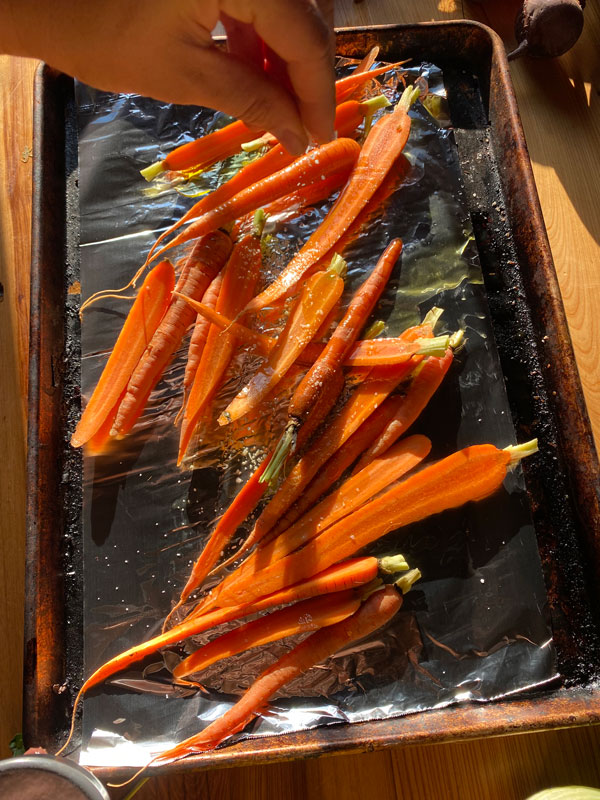Right around the time when Lonestar beer cans give way to their camo skins, I feel myself gathering armfuls of root crops to fill the larder and crowd my cutting board. This is not the season to naively enter the produce section with a hand basket instead of a push cart because you’re only grabbing “a few things.” Roots are dense, growing slowly underground and building mass by way of water and nutrients gathered from the surrounding soil. Botanically, roots anchor plants to the ground and function as a storage organ supplying the greens above with the energy they need to grow, bloom, and eventually reproduce. Gastronomically? They’re doing about the same.
Root vegetables and all their starchy wonders are the ideal guest to invite to your weekly dance in the kitchen. A big tray of roasted roots can easily mingle and marry with just about anything you’re able to whip up to fuel yourself during that Monday-Friday jive. Degree by degree, the temperatures here will eventually fall, and while that’s happening outside, we’re usually speeding up inside.
We all know the trajectory: back to school suddenly turns into pumpkins, morphs into turkeys, and then the holidays and their surrounding kerfuffle. Before you know it, we’ll be sipping cider and remembering the anniversary of the snowpocalypse. All this to say, when you get busy this fall and mindfulness seems like a practice of quarantine-past, why not give yourself over to the humble root and its easy ability to feed you?
Root vegetables like carrots, turnips, radishes, rutabaga, and potatoes (technically tubers) are easy to prepare in big batches and easy to incorporate into a nexus of meals throughout the week.
On the first night, enjoy roasted carrots, perfectly caramelized on the outside and bright orange on the inside, hot off the sheet pan. On the subsequent nights, you may decide to fold your carrots, or whatever roots you decided to make, into a tortilla, stir into a stew, or use them to add some heft and heart to a green salad.
All roots need salt. It’s the one ingredient absolutely necessary to nudge a beet from an underground appendage to a meal. I like to roast root vegetables at around 400-425 degrees – hot enough to actually brown the outside by the time the inside is tender.
It doesn’t matter what size you chop your vegetables so long as they are roughly the same size, which will allow them to cook at the same rate. I like to cut turnips into big wedges, the sides of which will develop a rich color when tossed with oil and spread out on a pan. I most often cut long colored carrots in half, lengthwise, and roast them this way. When done, they pile up so nicely like a stack of sweet, limp chopsticks, and when garnished with some chopped herbs or a drizzle of yogurt, your dinner guests will most certainly “ooh and aah,” mesmerized by your simple roasted root.
You can also grate a root… just about any root. I used to underestimate the utility of my box grater and kept it in the back corner of a large drawer. It tried to announce its fitness, inevitably jamming the drawer’s smooth operation, but it wasn’t until I watched a farmer friend whip up a grated root slaw in a matter of moments that I decided to relocate the grater from drawer to open shelf – just next to my cutting boards and favorite bowls. With little effort, you can also grate roots and turn them into a fritter or an okonomiyaki, a savory Japanese pancake. For the most part, roots behave the same, and you can use many root vegetables interchangeably, which is a part of their appeal. Anything a red beet touches, however, will obviously leave its mark.
Roasting and grating roots is great, but of course there are other ways to prepare them like frying, steaming, braising, or boiling. Beets and potatoes are my favorite vegetables to boil. Sometimes, while I’m washing the unfortunate pile of dishes intruding on my Zen, I’ll put a salty pot of water on to boil and drop in whatever roots need using. Boiling whole roots requires no cutting board or knife, and most importantly, even less attention than roasting. Though boiled veggies lack the texture you can achieve when roasting, there is plenty of time to add that later.
Toss boiled and peeled beets in butter and herbs on night one, and the leftovers can then be blitzed into a hummus-type dip on night two simply by adding a can of chickpeas, yogurt, and tahini. Boiled potatoes, stored in the fridge, have limitless potential. They can be mashed, fried, served as the base of a salad, or any other number of things that there isn’t time to mention here.
Perhaps one of the best root-crop transformations comes in the form of a creamy soup. Simply sauté an onion and garlic in some fat (like butter or olive oil), and then add to this pot whatever roots you have. This can be a combination of things, or a straight-run; you can even use leftover cooked roots, which will simply shorten the cooking time. Next, add a few cups of water or stock. Simmer until your roots are soft, and then blend it all together. Soup season is when my immersion blender earns its cupboard keep. As a final step, stir in some milk, cream, or the like. Milk is consumed quickly in my house and is rightfully prioritized for coffee and smoothies. Hence, I usually keep a few cans of coconut milk on hand. Truthfully, I prefer coconut milk for these creamy weekday soups and find I can eat bigger bowls with less consequence. Plus, coconut milk can live in the pantry, meaning I always have what I need for this meal.
If you’re shopping at a farmers’ market or trying to eat more seasonally, you know that cooking with what can grow in Texas at any given moment doesn’t exactly match what’s happening in the grocery store. This style of cooking – one which supports the livelihood of local farmers and a look towards agroecology – requires a spirit of flexibility.
Potatoes are a spring and early summer crop here in Texas though they’re ubiquitous in many soulful winter pots.
Turnips, rutabaga, or even the alien-like kohlrabi bulb (not technically a root, but who’s counting?) will happily fill in for a potato when there is none.
And when you do undoubtedly find yourself in the (beautiful) H-E-B produce section that miraculously boasts produce from equatorial tilts all over the world, take a moment to notice the players you may regularly overlook. At the Fredericksburg H-E-B, the bulk beets, rutabaga, and turnips live on the top left corner of the refrigerated shelves just near the door leading to the back. Don’t let their grizzly size or suspect hiding spot deter you: these root crops have a long shelf life, and even if you don’t immediately have a plan for them, why not grab a few bulbs to stock the fridge?
If there are bits of the farm still clinging to any root vegetables when you get home, kindly wipe them off, or if they’re especially clingy, fill up a bowl of water and soak the roots for a bit before scrubbing. If you’re lucky enough to get a bunch of carrots with the greens still attached, remove the greens from the root before storing each edible separately. If left attached, the leaves will continue to wick moisture from the roots, leaving limp ghosts of taproots past. The same goes for any root-and-green combo like bunched radishes, turnips, beets, or kohlrabi (once again, kohlrabi is more stem than it is root, but who’s counting). Properly storing your fresh produce will extend the shelf life of your precious food, helping prevent future compost trips and that all-too-familiar wasted-veggie shame spiral.
Crops like turnips, beets, carrots, and radishes, if divorced from their greens, will last anywhere from 3-6 months in the crisper drawer of a fridge. For the ultimate pioneer experience, you can store root crops in bins placed in a cool dark space. Either with a pan of water or a layer of damp sand, it’s important to introduce some element of humidity in a storage solution like this in order to prevent the crops from shriveling up.
Alternatively, you can always dig a deep hole in your backyard, line it with peat moss, and invest in some rodent-proof containers and build a backyard root cellar. Or, if you’re growing root crops in the garden, you can also experiment with simply leaving the crops in the ground, and harvesting as needed. To lessen the chances of frost damage, cover the plants with a thick layer of straw, and make sure to cut off (or seriously delay) the irrigation – too much moisture will cause the vegetables to rot. If you weren’t looking to involve shovels or integrated pest management strategy into your vegetable storage, then forget everything I’ve said, and just slide open that perfectly-suited crisper drawer and fill with roots.


